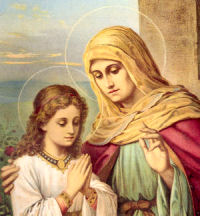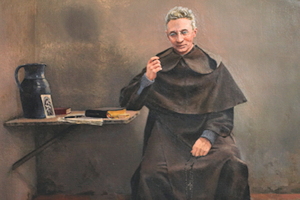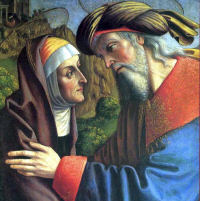Ordinary Time: July 26th
Memorial of Sts. Joachim and Anne, parents of Mary
Other Commemorations: St. Titus Brandsma, Priest and Martyr (RM)
» Enjoy our Liturgical Seasons series of e-books!
It was in the home of Joachim and Ann where the Virgin Mary received her training to be the Mother of God. Thus, devotion to Ann and Joachim is an extension of the affection Christians have always professed toward our Blessed Mother. We, too, owe a debt of gratitude to our parents for their help in our Christian formation.
According to the 1962 Missal of St. John XXIII the Extraordinary Form of the Roman Rite, today is the feast of St. Ann; St. Joachim's feast in this rite is celebrated on August 16.
Sts. Joachim and Anne
Who does not know about the great shrine of Ste. Anne de Beaupre in Canada, where miracles abound, where cured cripples leave their crutches, and where people come from thousands of miles to pray to the grandmother of Jesus? At one time, July 26 was the feast of St. Anne only, but with the new calendar the two feasts of the parents of the Blessed Virgin Mary have been joined and are celebrated today. Our information about Mary's parents comes from an apocryphal Christian writing, the Protoevangelium Jacobi (or Gospel of James), written about the year 170. According to this story, Joachim was a prominent and respected man who had no children, and he and his wife, Anne, looked upon this as a punishment from God. In answer to their prayers, Mary was born and was dedicated to God at a very early age.
 From this early Christian writing have come several of the feast days of Mary, particularly the Immaculate Conception, the Nativity of Mary, and her Assumption into Heaven. Very early also came feast days in honor of SS. Joachim and Anne, and in the Middle Ages numerous churches, chapels, and confraternities were dedicated to St. Anne. The couple early became models of Christian marriage, and their meeting at the Golden Gate in Jerusalem has been a favorite subject of Christian artists.
From this early Christian writing have come several of the feast days of Mary, particularly the Immaculate Conception, the Nativity of Mary, and her Assumption into Heaven. Very early also came feast days in honor of SS. Joachim and Anne, and in the Middle Ages numerous churches, chapels, and confraternities were dedicated to St. Anne. The couple early became models of Christian marriage, and their meeting at the Golden Gate in Jerusalem has been a favorite subject of Christian artists.
Anne is often shown in paintings with Jesus and Mary and is considered a subject that attracts attention, since Anne is the grandmother of Jesus. Her two great shrines — that of Ste. Anne d'Auray in Britanny, France, and that of Ste. Anne de Beaupre near Quebec in Canada — are very popular. We know little else about the lives of Mary's parents, but considering the person of Mary, they must have been two very remarkable people to have been given such a daughter and to have played so important a part in the work of the Redemption.
There is a church of St. Anne in Jerusalem and it is believed to be built on the site of the home of SS. Joachim and Anne, when they lived in Jerusalem.
—Excerpted from The One Year Book of Saints by Rev. Clifford Stevens
Patronage:
Anne: against poverty; barren; broommakers; cabinetmakers; carpenters; childless couples; equestrians; grandmothers; grandparents; homemakers; housewives; lace makers; lace workers; lost articles; miners; mothers; old-clothes dealers; pregnancy; pregnant women; horse riders; seamstresses; stablemen; sterility; turners; women in labour; Brittany; Canada; France; Quebec; archdiocese of Detroit, Michigan; diocese of Norwich, Connecticut; Santa Ana Indian Pueblo; Taos, New Mexico. See CatholicSaints.info for the complete list.
Joachim: fathers, grandfathers, grandparents; in Brazil: Alterosa, Montezuma, Porteirinha, São Joaquim de Bicas; Adjuntas, Puerto Rico
Symbols and Representation:
Anne: Book, symbol of her careful instruction of Mary; flowering rod; crown; nest of young birds; door; Golden Gate of Jerusalem; book; infant Virgin in crib; Shield has silver border masoned in black, with silver lily on a blue field referring to the girlhood of the Virgin.
Often Portrayed As: Woman holding Mary or Jesus in her arms or lap; Woman at her betrothal to Joachim; Mother teaching Mary to read the Bible; Woman greeting Saint Joachim at Golden Gate; Woman with a book in her hand.
Joachim: Basket containing doves; model of Golden Gate of Jerusalem.
Often Portrayed As: Man bringing a lamb to the altar and being turned away by the priest; greeting and/or kissing Saint Anne at the Golden Gate; elderly man carrying a basket of doves and a staff; elderly man with the child Mary.
Highlights and Things to Do:
- Learn more about Sts. Joachim and Anne:
- See more about the Shrine of Sainte Anne de Beaupré in Quebec, Canada. Several relics of St. Anne are also located in this shrine. Take a video tour of the Shrine here accompanied by beautiful Gregorian chant.
- See Christian Iconography for images related to St. Joachim and St. Anne
- Foods related to St. Anne and Joachim: It seems shellfish, particularly lobster, is one traditional type of food served in France for this feastday. See the suggested recipes in the left column.
This feast falls right in the middle of summer season, so keep in mind the variety of wonderful summer fruits and make something special with them, particularly fruit pies or tarts. A Continual Feast: A Cookbook to Celebrate the Joys of Family and Faith Throughout the Christian Year by Evelyn Vitz mentions that "[i]n both France and French Canada what would commonly be served on this occasion is a fruit tart: such exquisite desserts are traditional at all patronal festivals (as well as other special occasions), especially those falling in the summer, when such a luscious assortment of fruits is available." She includes two recipes, plum tart and apple tart. From Ignatius Press another cookbook called Cooking With the Saints includes recipes for St. Anne's Cream (Crème Sainte-Anne) and Anna Torte (Gateau Sainte-Anne). See Catholic Cuisine for foods for St. Anne.
One could also try to find "Bible foods" that St. Anne or the Blessed Virgin Mary would have cooked in their time. (But usually those aren't very festive!) This site gives some ideas on Biblical foods.
- As Joachim and Anne are the grandparents of Jesus, today has traditionally been a day to honor one's grandparents.
St. Titus Brandsma
 Anno Brandsma was born to Tjitsje and Titus Brandsma on February 23rd 1881 at Wonseradeel in Friesland, a province in the very north of Holland. The Brandsma family consisted of four girls and two boys, of which Titus was the second youngest. Five of the siblings would later enter religious life.
Anno Brandsma was born to Tjitsje and Titus Brandsma on February 23rd 1881 at Wonseradeel in Friesland, a province in the very north of Holland. The Brandsma family consisted of four girls and two boys, of which Titus was the second youngest. Five of the siblings would later enter religious life.
The family-owned a dairy farm and herd, selling milk and cheese made on the farm itself. At the time, Catholics were a minority in Friesland and protective of their religion and culture. Anno’s father worked to preserve the Friesian culture within his family and the local community. He participated in politics, and at one time served as chairman of the local election board.
When Anno had completed his secondary education at a Franciscan school, he decided to join the Carmelite Order. He began his novitiate at Boxmeer in September 1898 taking his father’s name, Titus, as his religious name. He made his First Profession in October 1899 and was ordained a priest on June 17th, 1905.
After further studies at the Gregorian University in Rome, he was awarded a Ph.D. in Philosophy in 1909.
Titus also had a keen interest in both Spirituality and Journalism, two areas which, together with his academic pursuits, would make up much of his life’s work.
In 1923, Titus helped found the Catholic University of Nijmegan, and worked there as a lecturer, professor and administrator. He served as Rector Magnificus (President) during the academic year 1932-33.
As a Carmelite friar, he also liked to share the Order’s spiritual tradition with people outside of the University.
 He traveled widely lecturing on Carmelite Spirituality. In preparation for a lecture tour in the United States in 1935, he spent some time at the Carmelite Priories in Whitefriar Street, Dublin, and Kinsale, Co. Cork, Ireland.
He traveled widely lecturing on Carmelite Spirituality. In preparation for a lecture tour in the United States in 1935, he spent some time at the Carmelite Priories in Whitefriar Street, Dublin, and Kinsale, Co. Cork, Ireland.
Titus also cultivated his interest in journalism and publishing. In late 1935 he became the National Spiritual Adviser to the Union of Catholic Journalists. In this role, he encouraged opposition to the publication of Nazi propaganda in Catholic newspapers and in the Press generally. He was especially critical of its anti-Semitism.
When the Nazis invaded Holland in May 1940, Titus was an adviser to the Archbishop of Utrecht. He encouraged the bishops to speak out against the persecution of the Jews and the infringement of human rights generally by the occupiers. In doing so, he became a marked man by the authorities.
The refusal by Catholic newspapers to print Nazi propaganda sealed the fate of Titus. Titus had agreed to deliver personally to each editor a letter from the Catholic bishops. This letter instructed the editors not to comply with a new law requiring them to print official Nazi advertisements and articles. Titus had visited fourteen editors before being arrested by the Gestapo at Nijmegen on January 19th, 1942.
Titus was interned at Scheveningen and Amersfoort in Holland before being transported to Dachau in June.
Under the harsh regime there, his health quickly deteriorated and he was in the camp hospital by the third week of July. He was subjected to biological experimentation before being killed by lethal injection on July 26th, 1942. On the day he died, the Dutch Bishops issued a pastoral letter protesting strongly against the deportation of Jews from Holland.
Before his execution, Titus had prayed that God might help the nurse who would administer the injection to repent of her actions in the camp. He also gave her his rosary beads, although she protested that she was a lapsed Catholic. Some years later, that same woman came to a Carmelite priority asking forgiveness and was a witness in the process for his beatification, which took place in Rome on November 3rd, 1985. He was canonized by Pope Francis on May 15, 2022.
—Excerpted from Carmelites
Highlights and Things to Do:
- Read the Vatican's summary of St. Titus' life here.
- Read Regis Martin's A Special Saint for Our Time.
- Learn more about St. Titus:
- Meditate on this beautiful prayer written by St. Titus while he was a prisoner at Scheveningen.
- Watch this video produced by the Irish Carmelites on St. Titus.








